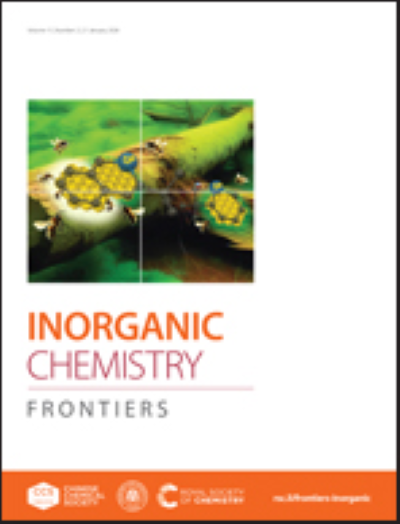A Tri-Alkali/Alkaline-Earth Metal Fluorophosphate Deep-Ultraviolet Birefringent Crystal with Coexisting PO3F and PO2F2
IF 6.1
1区 化学
Q1 CHEMISTRY, INORGANIC & NUCLEAR
引用次数: 0
Abstract
Deep-ultraviolet (deep-UV) birefringent crystals capable of generating or modulating deep-UV polarized lights are essential for modern laser technologies. However, there are few commercial deep-UV birefringent crystals, except MgF2, which exhibits tiny birefringence of 0.012@532 nm. Herein, by incorporating multiple alkali/alkaline-earth metal elements, the first tri-alkali/alkaline-earth metal fluorophosphate KBaSr(PO2F2)(PO3F)2 (KBSPF) with the coexistence of (PO3F)2- and (PO2F2)- has been successfully synthesized using the hydrothermal method. Experimental results indicate that KBSPF not only shows a wide transparency window down to the deep-UV spectral region, but also exhibits relatively large birefringence of 0.042@550 nm, exceeding that of commercial MgF2 and most alkali/alkaline-earth metal phosphates or fluorophosphates. Theoretical calculations reveal that (PO3F)2- and (PO2F2)- anions are responsible to the optical properties of KBSPF. Our work not only provides a promising deep-UV birefringent crystal but also offers new insights to enrich the solid-state chemistry of fluorophosphates.PO3F和PO2F2共存的三碱/碱土金属氟磷酸盐深紫外双折射晶体
能够产生或调制深紫外偏振光的深紫外双折射晶体是现代激光技术所必需的。然而,很少有商业的深紫外双折射晶体,除了MgF2,它具有微小的0.012@532 nm的双折射。本文采用水热法制备了(PO3F)2-和(PO2F2)-共存的第一个三碱/碱土金属氟磷酸盐KBaSr(PO2F2)(PO3F)2 (KBSPF)。实验结果表明,KBSPF不仅具有宽的透明窗口至深紫外光谱区,而且具有相对较大的0.042@550 nm双折射,超过了商用MgF2和大多数碱/碱土金属磷酸盐或氟磷酸盐。理论计算表明(PO3F)2-和(PO2F2)-阴离子对KBSPF的光学特性有重要影响。我们的工作不仅提供了一个有前途的深紫外双折射晶体,而且为丰富氟磷酸盐的固态化学提供了新的见解。
本文章由计算机程序翻译,如有差异,请以英文原文为准。
求助全文
约1分钟内获得全文
求助全文
来源期刊

Inorganic Chemistry Frontiers
CHEMISTRY, INORGANIC & NUCLEAR-
CiteScore
10.40
自引率
7.10%
发文量
587
审稿时长
1.2 months
期刊介绍:
The international, high quality journal for interdisciplinary research between inorganic chemistry and related subjects
 求助内容:
求助内容: 应助结果提醒方式:
应助结果提醒方式:


